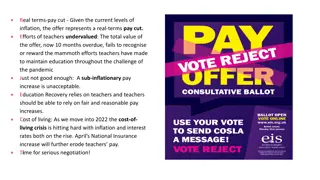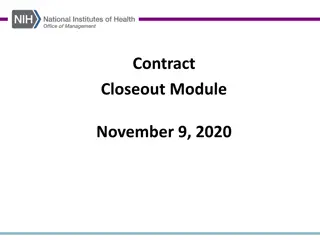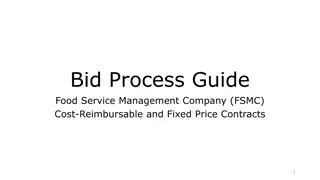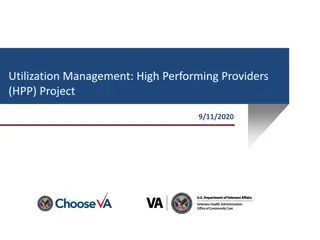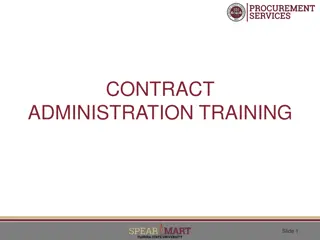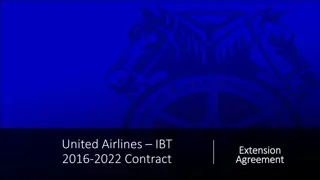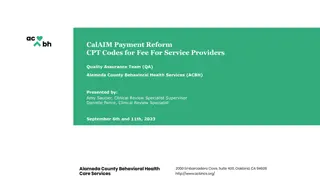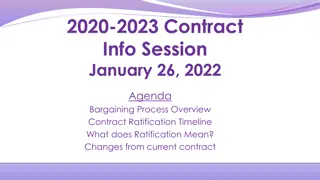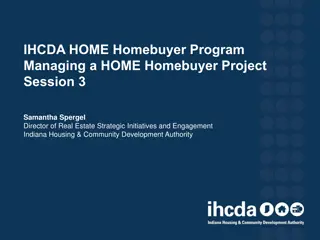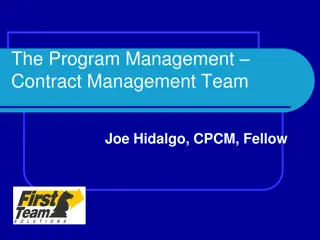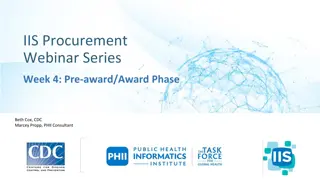Navigating Contract Terms and Negotiations: Key Considerations for ABA Providers
Industry professionals discuss essential considerations for ABA providers when navigating contract terms and negotiations, emphasizing the importance of understanding insurance guidelines, reviewing contract terms thoroughly, and being aware of key aspects such as timely filing deadlines and payment terms.
Download Presentation

Please find below an Image/Link to download the presentation.
The content on the website is provided AS IS for your information and personal use only. It may not be sold, licensed, or shared on other websites without obtaining consent from the author. Download presentation by click this link. If you encounter any issues during the download, it is possible that the publisher has removed the file from their server.
E N D
Presentation Transcript
Roundtable Discussion Emily Roche Director of ABA Services Gersh ABA Services Sara Gershfeld Litvak, MA, BCBA CEO Behavioral Health Center of Excellence Diana Wolf, MA, BCBA, LBA Co-CEO Verbal Beginnings Michele Silcox, CMRS CEO ABA Therapy Billing and Insurance Services and MS Consulting, LLC
General Disclaimer The following presentation is intended as a discussion from four industry professionals providing a view into Navigating Contract Terms and Negotiations. This presentation reflects our best understanding of the processes. Providers are encouraged to confirm all information presented by reviewing their own independent contracts, business practices and in payor relations with provider representatives. This presentation does not reflect opinions of any organization outside of those represented as roundtable presenters.
Get to Know Your Contracts There s more to it than rates! Presented By: Emily Roche
Careful Consideration and Big Decisions Is accepting insurance right for you business? What are the ABA guidelines from the payor? Are they sustainable for your business? The contract is legally binding for your business, and many of the terms favor the insurance company or the member. And, the burden is on you to process all authorizations and claims. Don t always follow what other companies are doing . You don t know if what another company is doing has been financial sustainable, has the same terms, etc.
Contract Terms to Review Boilerplate Contracts: not made specifically for ABA providers Know your state laws that apply Read your whole contract! And, ask for ABA specific guidelines Know where to find your provider manual These terms are considered binding along with the contract Notice of Material Change or Amendment**** How do you receive notice of a material change? How can you dispute a material change?
Contract Terms to Review - continued Timely Filing Deadline How are claims submitted Electronic, through a portal, paper claims, etc. Deadline for Appeals Term of the contract How long you are locked into the contract? Period for timely payments How long can insurance take to pay you? Interest on late payments
What Does the Contract Cover? Covered Products: PPO, EPO, HMO, etc. Does the HMO have additional requirements? Medicaid and CHP+ Do you have to accept Medicaid or CHP+ members covered by the payor? Group vs. Individual Contracts If you plan to grow, attempt to get group contracts Who handles ABA authorizations?
Fee Schedules Be sure to ALWAYS have the fee schedule before signing a contract. Before negotiating rates . Know how to calculate your profit margins If using a tiered model . Rates on behavior technician services supply the profit margin Do not think a high BCBA rate can compensate for a low RBT/BT rate Calculate how much profit is made on each rate Then, calculate how many billable hours you provide of each service! Technician: $25 profit per hour x 400 hours per week x 48 weeks = $480,000 BCBA: $25 profit per hour x 45 billable hours per week x 48 weeks = $54,000
Reimbursement Rates: Sharing the Value of Your Organization Presented by: Sara Gershfeld Litvak, MA, BCBA
Readiness is Everything Understand the market and strengths of your own practice SWOT Analysis Utilization Number of new patient referrals per month Know your market share Survey patient satisfaction (BHCOE offers this) Benchmark aspects of your quality & efficiency Before meeting with representatives of healthcare plans, find out how significant your referral sources and footprint is in their network
Analyze the Fee Schedule Quick and Dirty Approach : Create a spreadsheet with every CPT code and the number of times it was billed for that payer Multiply the use of each code by the proposed payment of the payer. Add together all of these products and divide by the total frequency of all codes to determine the weighted average payment for that payer. By repeating this process for each payer, you can compare the overall weighted averages of all of your health care plans.
Next Determine the break-even point for your practice by adding: Overhead expenses Compensation Dividing this sum by total frequency of all codes for all payers This will give you the weighted average of your costs, your break-even point, and compare it with weighted average reimbursement for each contract. You can also do this analysis by service line some service lines are more profitable than others You can also compare this as a % compared to Medicaid rates
Monitor Your Contracts Most contracts are evergreen and automatically renew unless modification is proposed As the date approaches, analyze the contract and determine changes It is not advisable to allow contracts to go unchanged for many years. It s easier to ask for a 1-3% increase every few years than a 10% increase all at once. Channel all contact with a healthcare plan through only one person. This person also communicates changes to clinical staff. Clinicians should not sign paperwork addressing rates, reimbursement, etc. Be careful with this. Do not sign membership confirmation letters.
Determine Your Position Set a bargaining range that includes optimum, minimum and target goal. Optimum: starting point Minimum: needed for you to sign Target: point at which you would like to end up after negotiation BATNA: Best Alternative to a Negotiated Agreement Go into negotiations knowing your alternatives BATNA: option you take if no agreement is met Your position is weaker if you are primarily servicing one payer. It s important to monitor your payer mix annually.
When Should You Walk Away? Decide on your bottom line ahead of time Do not accept truly poor contract terms just because it would cause disruption of ongoing care, decrease in new patients or loss of income. Case study: One business walked away from a poorly written contract that resulted in displacing more than 200 patients. They stuck to their guns, and it was well worth it. Eight month later, the plan said We want you back in our network.
Negotiating the Contract Common Response to Clinicians: This is what we pay in your market, and you're simply going to have to accept it. Contact the plan representative to set a date for a face-to-face meeting at your office. At the meeting, present well-organized, clear data. Many providers use the BHCOE Accreditation Results for this process. Make it plain that you have a thorough understanding of the finances of your practice. Present your requests for changes asking for your optimum objective before new terms are offered. Listen carefully to what they have to say, and do not interrupt. A basic negotiating principle is to remember that you are negotiating a relationship, not a transaction.5
Negotiating the Contract Find out the goals of the other party Find out the biggest issues the payer has and try to address them Payers want cost control, predictable cost and progress. Show them you can provide that. Be prepared to share the following: Practice data Outcome Data Patient Satisfaction Data Staff Turnover & Staff Satisfaction (Happy Staff = Happy Patients) If you can, negotiate a multi-year contract with escalation of fees every year. This is less burdensome for payers, but ends up at the desired rate.
What else to negotiate? Authorization process Period specified for submitting claims (try pushing to 120 vs. 90 days) Period allowed to appeal a denied claim Requirements regarding assessments used Time specified for timely payments, and interest paid for late payment Period required for providing notice of modifications Cancellation clause, including advanced notice required
Preparing for Rate Negotiations Presented by: Diana Wolf MA, BCBA, LBA
Pre-requisites of Rate Negotiations Have a full understanding of the new CPT codes Know what is in your contracts Know your numbers... Your needs Know the people who will listen and help
CPT codes What is the intended use of the codes? APBA webinars https://www.apbahome.net/store/ListProducts.aspx?catid=694517&ftr BHCOE webinar https://bhcoe.org/behavioral-health-virtual-academy/ ABA Therapy Billing and Insurance Services https://www.ababilling.net/blog/ How are they different from CPT III codes? What does the CPT manual say? What does the CPT Assistant article say?
Contracts Not knowing can cost you! Medical Necessity provision Billing outside of an authorization Balance billing Timely filing provision How long insurance companies have to pay you Fee schedule alterations Clauses to hold members harmless Adjustments to payment overpaid/underpaid Clause about ineligible members Notices Termination AND MORE! (All are payer specific know what you re signing!)
Know your numbers Get an accountant Run an analysis of your organization What exactly is involved in pre-service per code What exactly is involved in post-service per code How much time spent for each activity What are our disposable and non-disposable supplies used Find out what your company rates are (per code) when they re bundled vs. if you had a separate indirect service code to use
Who do you contact? Important to build relationships with people on the insurance side Start with provider relations Do you have a specific contact? Do you have a contact through authorization department? Can they lead you to the right person? If your contract amendments for new codes are not reflecting a number that would work with your calculations, send a counter-offer with a rationale. Use your resources AMA CPT Manual/Assistant article Webinars and presentations by members of steering committee Practice Guidelines for Health Funders from the BACB White Paper explaining effectiveness of ABA from APBA
Show your worth Explain why you need what you need and why their proposed rates won t cut it Show the number of their members your organization is providing services for Show outcome measures If accredited, list accreditations and what they mean Survey your clients client satisfaction scores go a long way
Dont Back Down Most insurance companies know very little about ABA and how the therapy works Educate your payers You got this!
Understanding Intent and Implementation Presented by: Michele Silcox, CMRS
Remember your WHY WHY do I need to review my contracts? WHY do I need to know the intent of the codes? WHY do I need to understand implementation of the codes? WHY do I need to understand that the full ABA program costs cover all services, overhead and expenses? WHY do I need a voluntary internal compliance program?
Intent vs Implementation Intent of Category I codes has been covered by the presentations from Gina Green, APBA and Jenna Minton, Minton Healthcare Strategies from the Steering Committee for the New CPT Codes for Adaptive Behavior Services Grounding yourself in the Intent will give you an advantage in your payor relation contract and authorization conversations Implementation of Category I codes is at 100% discretion of the Payor. Having as much knowledge as possible about the codes and your organization will set you up for success in making business decisions and reviewing your contracts
Example of Implementation for Category III Codes The View in Billing Code Format - BEFORE All Health Plans Indirect Services/Treatment Planning TRICARE only- Supervised Fieldwork/ Protocol Modification Other Health Plans - Supervision/Protocol Modification 0360T/0361T 0368T/0369T Stand-alone codes such as: H0031, H0032, G9012 were present in some payor contracts for case management Supervised Fieldwork (used in a non Standard way by TRICARE only) Allowed to be conducted using telehealth Supervision/Protocol Modification Does not require technician be present Not designed for some non face- to-face supervisory activities not involved in individualized clinical treatment TRICARE: 0368T/0369T for treatment team meetings defined in the TOM Did not require beneficiary be present 0368T/0369T Some payors allowed 0368T/0369T for other non face-to-face uses such as team meetings or treatment planning Protocol Modification Possible underused by providers while performing these activities naturally during a supervision session
Example of Implementation for Category I Codes The View in Billing Code Format - AFTER Other Health Plans Supervision/Protocol Modification All Health Plans Indirect Services/Treatment Planning Category I codes do not allow for non face-to-face activities with the exception of 97151 Behavior Identification Assessment TRICARE only Protocol Modification Supervised Fieldwork 97155 - No longer required or reimbursed Adaptive behavior treatment with protocol modification which may include simultaneous direction of technician Does not require technician be present Not designed for some non face-to- face supervisory activities not involved in individualized clinical treatment Actively engaged with the client 97155 Adaptive behavior treatment with protocol modification which may include simultaneous direction of technician Direction allowed only on-site during protocol modification Meeting TRICARE definition of protocol modification (refer to updated TOM and DHA documentation of changes Actively engaged with the client Stand-alone codes such as: H0031, H0032, G9012 may be present in your contract fee schedule with some payors and could be defined as used for treatment planning
Lets Do The Math TRICARE as of 1/1/19 Protocol Modification (face-to-face) TRICARE as of 1/1/19 Supervised Fieldwork (face-to-face) TRICARE through 12/31/18 (face-to-face) *using TRICARE standard published rates as a mathematical example *using TRICARE standard published rates as a mathematical example *using TRICARE standard published rates as a mathematical example 97155 No Code 0360T/0361T or 0368T/0369T 1 hour BCBA = $125 per hour 1 hour BCBA = $0 per hour 1 hour BCBA = $125 per hour 97153 97153 0364T/0365T 1 hour RBT = $50 per hour 1 hour RBT = $50 per hour 1 hour RBT = $50 per hour Billable: Billable: Billable: $125 per hour $50 per hour $125 per hour Net change ($75.00) per hour *when choosing to do Supervised Fieldwork activities that are not covered with 97155 Protocol Modification
Unanswered Questions Different Interpretation of Codes = Difficult Implementation With Payors being allowed to interpret the codes for implementation based on individual payor policy, you will need a master grid of information for crosswalking and moving forward in your business Category I codes do not cover indirect services (non face-to face) with the exception of 97151 There is not a direct crosswalk for treatment planning from Category III to Category I codes Some Payor were using Category III codes in a non standard way Seek to obtain a stand-alone code Things to watch for: Concurrent billing Different use of 97155 Treatment by Protocol by QHP (97153 or 97155?) defined by Payor Primary/Secondary use of different codes and differing use of same code
Advocacy Use all available resources to discuss the intent of the codes with Payors Payor provider reps and claims specialists are learning the codes too If the Payor Policy is not documented and published, don t take the guidance in a phone call that is misaligned with the intent without seeking to speak to a decision maker with the health plan and ask for information in writing Rather than seeking for what you can do in writing (eg concurrent billing); utilize the intent and guidance from AMA and the Steering Committee Advocate for your Business! Participate in your state ABA Chapter Become a leader in advocating for the industry
Voluntary Internal Compliance Program Seven components that provide a solid basis upon which a physician practice can create a voluntary compliance program: 1. Conducting internal monitoring and auditing; 2. Implementing compliance and practice standards; 3. Designating a compliance officer or contact; 4. Conducting appropriate training and education; 5. Responding appropriately to detected offenses and developing corrective action; 6. Developing open lines of communication; and 7. Enforcing disciplinary standards through well-publicized guidelines. https://oig.hhs.gov/authorities/docs/physician.pdf





